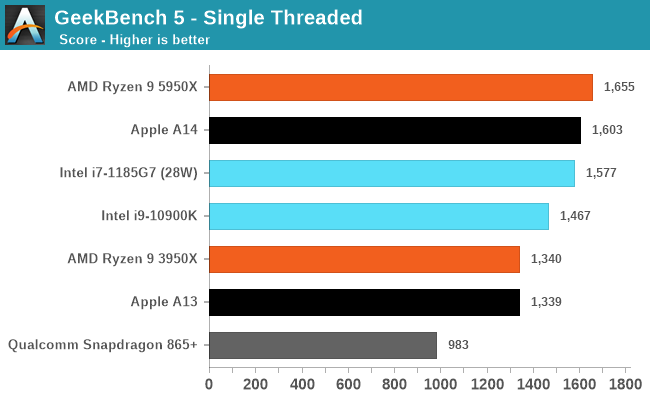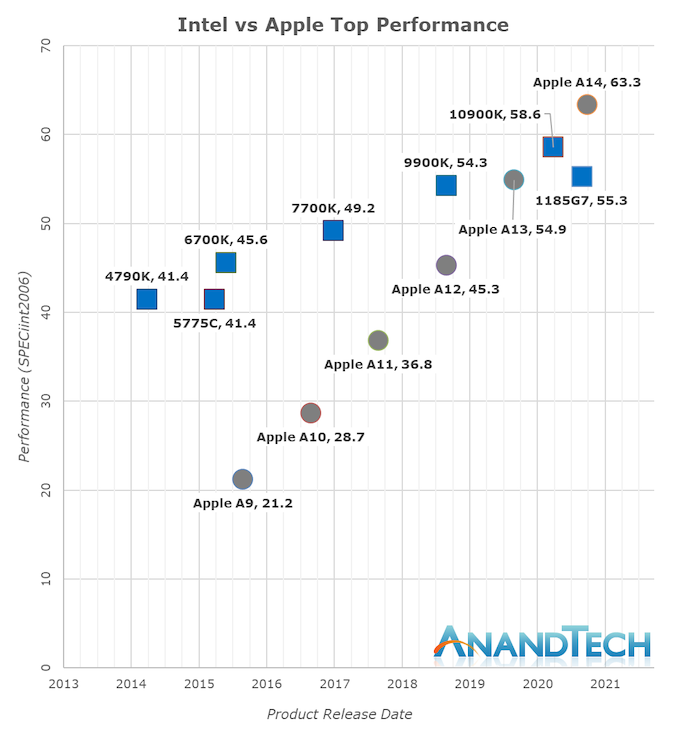Apple Announces The Apple Silicon M1: Ditching x86 - What to Expect, Based on A14
by Andrei Frumusanu on November 10, 2020 3:00 PM EST- Posted in
- Apple
- Apple A14
- Apple Silicon
- Apple M1
From Mobile to Mac: What to Expect?
To date, our performance comparisons for Apple’s chipsets have always been in the context of iPhone reviews, with the juxtaposition to x86 designs being a rather small footnote within the context of the articles. Today’s Apple Silicon launch event completely changes the narrative of what we portray in terms of performance, setting aside the typical apples vs oranges comparisons people usually argument with.
We currently do not have Apple Silicon devices and likely won’t get our hands on them for another few weeks, but we do have the A14, and expect the new Mac chips to be strongly based on the microarchitecture we’re seeing employed in the iPhone designs. Of course, we’re still comparing a phone chip versus a high-end laptop and even a high-end desktop chip, but given the performance numbers, that’s also exactly the point we’re trying to make here, setting the stage as the bare minimum of what Apple could achieve with their new Apple Silicon Mac chips.

The performance numbers of the A14 on this chart is relatively mind-boggling. If I were to release this data with the label of the A14 hidden, one would guess that the data-points came from some other x86 SKU from either AMD or Intel. The fact that the A14 currently competes with the very best top-performance designs that the x86 vendors have on the market today is just an astonishing feat.
Looking into the detailed scores, what again amazes me is the fact that the A14 not only keeps up, but actually beats both these competitors in memory-latency sensitive workloads such as 429.mcf and 471.omnetpp, even though they either have the same memory (i7-1185G7 with LPDDR4X-4266), or desktop-grade memory (5950X with DDR-3200).
Again, disregard the 456.hmmer score advantage of the A14, that’s majorly due to compiler discrepancies, subtract 33% for a more apt comparison figure.

Even in SPECfp which is even more dominated by memory heavy workloads, the A14 not only keeps up, but generally beats the Intel CPU design more often than not. AMD also wouldn’t be looking good if not for the recently released Zen3 design.

In the overall SPEC2006 chart, the A14 is performing absolutely fantastic, taking the lead in absolute performance only falling short of AMD’s recent Ryzen 5000 series.
The fact that Apple is able to achieve this in a total device power consumption of 5W including the SoC, DRAM, and regulators, versus +21W (1185G7) and 49W (5950X) package power figures, without DRAM or regulation, is absolutely mind-blowing.

There’s been a lot of criticism about more common benchmark suites such as GeekBench, but frankly I've found these concerns or arguments to be quite unfounded. The only factual differences between workloads in SPEC and workloads in GB5 is that the latter has less outlier tests which are memory-heavy, meaning it’s more of a CPU benchmark whereas SPEC has more tendency towards CPU+DRAM.
The fact that Apple does well in both workloads is evidence that they have an extremely well-balanced microarchitecture, and that Apple Silicon will be able to scale up to “desktop workloads” in terms of performance without much issue.
Where the Performance Trajectory Finally Intersects
During the release of the A7, people were pretty dismissive of the fact that Apple had called their microarchitecture a desktop-class design. People were also very dismissive of us calling the A11 and A12 reaching near desktop level performance figures a few years back, and today marks an important moment in time for the industry as Apple’s A14 now clearly is able to showcase performance that’s beyond the best that Intel can offer. It’s been a performance trajectory that’s been steadily executing and progressing for years:
Whilst in the past 5 years Intel has managed to increase their best single-thread performance by about 28%, Apple has managed to improve their designs by 198%, or 2.98x (let’s call it 3x) the performance of the Apple A9 of late 2015.
Apple’s performance trajectory and unquestioned execution over these years is what has made Apple Silicon a reality today. Anybody looking at the absurdness of that graph will realise that there simply was no other choice but for Apple to ditch Intel and x86 in favour of their own in-house microarchitecture – staying par for the course would have meant stagnation and worse consumer products.
Today’s announcements only covered Apple’s laptop-class Apple Silicon, whilst we don’t know the details at time of writing as to what Apple will be presenting, Apple’s enormous power efficiency advantage means that the new chip will be able to offer either vastly increased battery life, and/or, vastly increased performance, compared to the current Intel MacBook line-up.
Apple has claimed that they will completely transition their whole consumer line-up to Apple Silicon within two years, which is an indicator that we’ll be seeing a high-TDP many-core design to power a future Mac Pro. If the company is able to continue on their current performance trajectory, it will look extremely impressive.











644 Comments
View All Comments
daveedvdv - Thursday, November 12, 2020 - link
Fun fact: One of the ways Rosetta 2 is faster than the original Rosetta (which was no slouch) is that Rosetta 2 doesn't have to do endianness transcription.dotjaz - Wednesday, November 11, 2020 - link
Several? More like one. X1 is quite close to Lightning (int) and Firestorm (fp).bobdesnos - Tuesday, November 10, 2020 - link
need 4 ys after we will seeLuminar - Wednesday, November 11, 2020 - link
X1 is probably dead in the waterSpunjji - Thursday, November 12, 2020 - link
Not really - it won't have to compete with Apple's CPU in any market besides phones, and TBH Android and iOS aren't really "competitors" in that sense.misan - Wednesday, November 11, 2020 - link
I think you are missing the point where Zen3 is consuming 4 times the power to get comparable performance. These tests re comparing a sub 5 watt phone CPU to latest and greatest of x86 desktop CPUs. I believe the ridiculousness of this situation has not properly sank in yet.vais - Wednesday, November 11, 2020 - link
I don't understand what exactly those benchmarks are testing. Even it apple's architecture is 3-4 times more efficient, such close scores are unexpected between a 5watt vs 110 watt CPUs.To me it seems this benchmark doesn't accurately represent the real world performance of the different CPUs.
Coldfriction - Wednesday, November 11, 2020 - link
My opinion is that using dedicated silicon for a specific task and not generic CPU computing is where almost ALL of the improved performance comes from. Apple is including a lot of dedicated silicon that isn't just general computing. A Zen 3 Ryzen has some of that, but most of it is general computing. Programmable silicon will never be as fast as dedicated silicon. The M1 will look great for very specific things, and admittedly they'll be the very specific things that Apple users use the most, so it's likely a win for them. The technological claims however are bogus. Like you said, there's essentially no way that Apple made a general computing CPU that is faster than Intel or AMD; it's all the dedicated silicon.michael2k - Wednesday, November 11, 2020 - link
Like you said, there's essentially no way that Apple made a general computing CPU that is faster than Intel or AMD; it's all the dedicated silicon.It’s like you didn’t read this article or any other Anandtech article on Apple’ A series CPUs. It’s got an 8 wide cpu design; wider than Intel or AMD, it’s got 12MB L2 cache, and a much larger reorder buffer. It’s also got 8 cores, larger than Intel’s default 4 or 6, even if half of them are the efficiency cores.
Coldfriction - Wednesday, November 11, 2020 - link
No doubt what they have is efficient. But their claims are out of this world high. If it was simply a matter of making a wider CPU design, AMD or Intel would have done exactly that years ago. If it were simply a matter of making a larger L2 cache, AMD or Intel would have done that years ago.The claims are extraordinary, very extraordinary. Extraordinary claims need extraordinary evidence. Apple didn't provide that. We have yet to see any real details and this article is very very specific using a very small scale test.
CPU design is somewhat of a solved art these days. When you normalize things a specific way, it looks like things are better than they are in absolute terms. I've no doubt Apple has the best performing CPU cores for the power, but that isn't in absolute terms.
What this article needs to emphasize is that custom built silicon ALWAYS punches above its weight and performs better than generic computing devices EVER will. I watched the M1 presentation. The games looked anemic and low FPS. That's not 3X more powerful or whatever they were claiming. I want absolute performance, not normalized against specific metric performance. I also want full compatibility and not a locked ecosystem. I'll never buy a locked down Apple product like this because of the cage it would put me in.